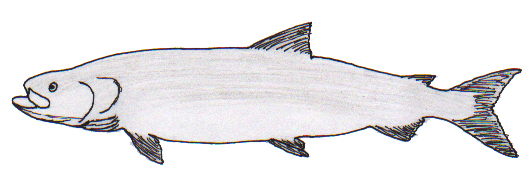 This collection of student work is from Frank Keim's classes. He wants to share these works for others to use as an example of culturally-based curriculum and documentation. These documents have been OCR-scanned and are available for educational use only.
This collection of student work is from Frank Keim's classes. He wants to share these works for others to use as an example of culturally-based curriculum and documentation. These documents have been OCR-scanned and are available for educational use only.Special | A | B | C | D | E | F | G | H | I | J | K | L | M | N | O
P | Q | R | S | T | U | V | W | X | Y | Z | ALL
The Sheefish in Alaska:
The Sheefish in Alaska
(Stenodus Ieucichthyus nelma) (Cii) The Sheefish was called inconnu (unknown fish) by the early French explorers, and is found only in arctic and subarctic North America and Siberia. A few are found in the smaller rivers of Norton Sound. It is incredibly abundant at times and nonexistent in the same waters a short time later. Its tremendous size, fighting ability and fine eating qualities make the sheefish one of the most unique trophy fish in North America. The Sheefish is a member of the whitefish family but is distinguishable from the more common whitefish by its strong extended lower jaw. The color is silvery with a darker color on the dorsal fin. It has a purple sheen when it is taken from the water. The males and females are similar but the females live longer and are a larger size. Sheefish in the Selawik-Kobuk area weigh up to sixty pounds while Interior Alaska fish reach twenty pounds. Sheefish in Alaska have been separated into five major populations. Upstream migration from the wintering grounds begins during breakup. The migration ranges from a few weeks in the upper Yukon to over four months in the lower Yukon River where sheefish travel one thousand miles upstream to spawn in the Alatna River. A twelve pound spawning female may contain one hundred thousand eggs while a fifty pound female contains up to four hundred thousand eggs. Sheefish do not dig nests for the eggs. The female spawns at the surface of the water with the male swimming underneath fertilizing the eggs. The fertilized eggs then fall to the bottom of the stream in the gravel. Sheefish do not die after spawning and live to spawn again. At six months the eggs start to hatch. When the eggs become fry they travel downstream during the spring and start to feed on plankton. Their diet changes to insect larvae and small fish, and by the second year of life they feed almost entirely on fish. Males mature from age five to nine and females from age seven to eleven. Adults eat any fish available, such as ciscoes, salmon smolts, pike, smelt and other whitefish. Sheefish is a subsistence food for Natives and their dogs. They can be taken at the mouth of clear water streams of the Yukon River throughout the summer. The best fishing time on the Yukon is the last two weeks of September, and on the Kuskokwim in July. Tatiana Sergie
| |
|




